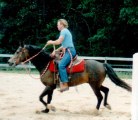More on hay quality, recognition, and allowances...
HAY QUALITY AND FEEDING
Last week we discussed the hay with the highest protein and highest digestibility. Our conclusion was that this late cutting alfalfa hay can be fed if it is introduced to the horse slowly and is not the only roughage available. It is an excellent hay for foals, brood mares, hard working stallions, and horses being conditioned for show.
At the other end of the hay quality scale is a first cutting grass hay that was baled well after maturity of the plant. This might be fescue hay made after the heads were combined and/or the stems had turned yellow. This can also be a native grass hay cut after maturity. I am sure none of us would knowingly buy such a hay, but being able to recognize it and its characteristics will help us judge the quality of our hay:
To summarize, the hay looks like straw.
The above grass hay will be very high in fiber which means it is very poorly digested. If there is anything else to eat, such as grass in fence rows, your horse will eat that before touching this hay. The protein content percentage will be in single digits, at best.
When this is the only roughage fed, it will affect the appearance of the horse. They will have  very large abdomens but will be under-conditioned. A roughage this coarse moves along the bowel slowly, because the body is trying to recover the nutrients but must first break down the fiber. Meanwhile, Dobbin (although from the looks of him, we will think Dobbin has ever been fed any of this hay) will still feel hungry. He will continue to eat because his appetite has not been satisfied. This will crowd more hay into his stomach and intestines, which must then expand to hold what is already there as well as incoming hay. As the intestines grow in size, there must be more room for them, so the abdomen wall stretches giving him a belly-size out of proportion to his body size. The stool will be formed and very hard.
very large abdomens but will be under-conditioned. A roughage this coarse moves along the bowel slowly, because the body is trying to recover the nutrients but must first break down the fiber. Meanwhile, Dobbin (although from the looks of him, we will think Dobbin has ever been fed any of this hay) will still feel hungry. He will continue to eat because his appetite has not been satisfied. This will crowd more hay into his stomach and intestines, which must then expand to hold what is already there as well as incoming hay. As the intestines grow in size, there must be more room for them, so the abdomen wall stretches giving him a belly-size out of proportion to his body size. The stool will be formed and very hard.
When you check them for fat cover, there may be none detectable, with the skin laying against the ribs. The top line (back bone) may be just as hard. This is because the surrounding supporting muscle is being broken down, consumed by the body in an attempt to gain nutrients, leaving the tops of the vertebra sticking up. By the time the horse is in this condition, its attitude will also be affected. Dobbin will droop around, running only to move out of the way of another horse.
If this is the only hay available, supplementing it with grain is necessary. Grain will provide protein and energy, as well as some of the necessary vitamins and minerals. Some of the alfalfa we discussed earlier would be very beneficial, because the low quality grass hay will provide sufficient roughage. This is one place where the horse will voluntarily eat such a hay. When the alfalfa starts irritating his bowel, he will search out the longer stem hay, just to add its physical presence within the intestine. Also, as he chews the coarse hay, saliva is released. Since it takes longer to chew this hay, more saliva is swallowed with the hay. Saliva is high in bicarbonates, which will neutralize any excess acid generated in the stomach because of the high protein, high energy feeds.
There is only one class of horse where such a rough hay should be fed. This is the overweight horse that is not losing weight, even after being dry lotted. This hay will provide a pastime and keep the bowel active, while providing little else to get fat on!
The rule of thumb for the amount of roughage the horse must have each day is 2% of its body weight. For the 1000 pound horse, this would equal 20 pounds. As we know, the horse will eat more than this amount, so we must monitor its body condition and adjust the intake appropriately.
As we discussed before, it is our preference that hay or grass be the primary feed. If the horse does not maintain its body condition on the 20 pounds, it is usually more economical to increase the amount and quality of hay than to buy grain. However, in the heavily worked horse or the growing youngsters, some grain should be fed. The other horses will expect some grain as well. I suspect that on most farms, they will receive grain also: so that the horse and owner can feel good about it.
CLICK BELOW TO DISPLAY A PRINTER-FRIENDLY COPY OF THIS ARTICLE
Select "Open this file from its current location," if you just want to print it out,
it will open in a simple word processing application, select the print button.
(unless you want to save this article in your computer's memory)

 HAY_QUALITY_AND_FEEDING.rtf
HAY_QUALITY_AND_FEEDING.rtf